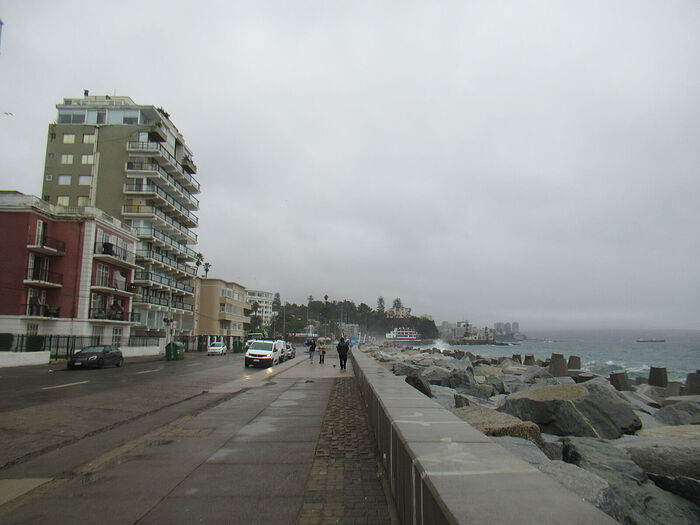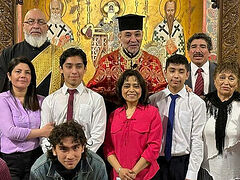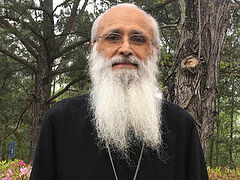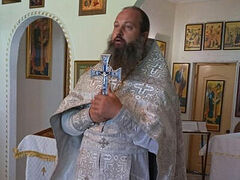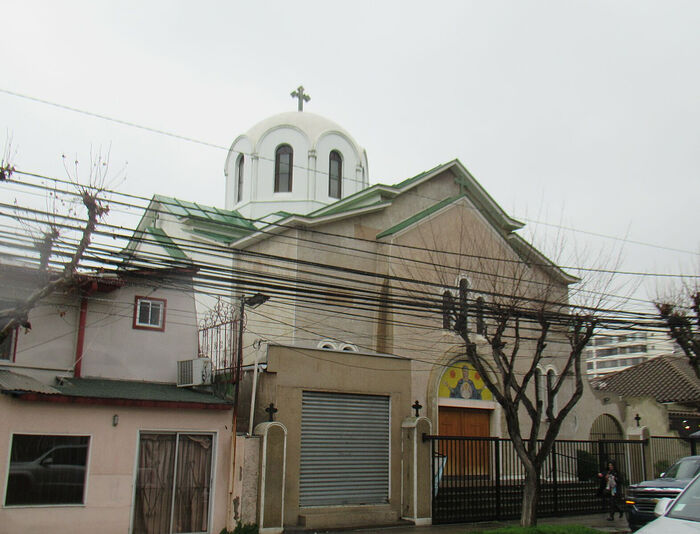 Church of the Dormition of the Theotokos (Viña del Mar; Chile)
Church of the Dormition of the Theotokos (Viña del Mar; Chile)
Vina del Mar is a Chilean resort town located about 75 miles northwest of Santiago. Buses run here regularly from the capital of Chile, taking passengers from the huge, chaotic Santiago to more tranquil places on the Pacific coast. Life in Vina is quieter and more comfortable than in the big city, largely thanks to a more equable climate (it doesn’t have the unbearably hot weather, like in the capital) and a more favorable environment. True, Vina has its own natural nuances; they are eloquently indicated by the signs showing evacuation routes for residents to follow in the event of a cataclysm—a tsunami.
Anyone who comes from Europe to this seemingly forgotten town at the back of beyond will be pleased and a little surprised to learn that there is an Orthodox church here. Not just a community renting a tiny space in a Catholic or Protestant church (as is often the case), but a separate complex with a church building and additional outbuildings.
It is worth noting that the Church of the Dormition of the Theotokos in Vina del Mar is approaching its sixtieth anniversary—it was built through the efforts of patrons and parishioners in the 1960s. The Arab and Greek diasporas, headed by Juan Massu and Georges Moustakis, contributed much to the construction of the church. The church was consecrated on February 14, 1965.
The church is situated at 1 Poniente Street 420, about a half-hour walk from the bus station and a 10-minute walk from the ocean. You can distinguish that this is an Orthodox church by a mosaic icon of the Mother of God on the facade of the building. Priest Jorge (George) Suez has served here for almost twenty years. I was abke to speak with batiushka during a short trip to Chile, which included a visit to Vina del Mar.
 Portraits of Juan Massu and Georges Moustakis
Portraits of Juan Massu and Georges Moustakis
“My ancestors lived in Jordan, in the city of Madaba,” Fr. Jorge related. “My great-grandfather was a priest. My grandfather left Jordan in the 1920s and emigrated to Chile. Here he got married, and our family settled down in South America.”
Being Orthodox from birth, Fr. Jorge obtained his education in the Middle East—he graduated from the Balamand Seminary (Lebanon). In 1999, he was ordained a priest; he served in the Cathedral of the Patriarchate of Antioch in Santiago. He moved to the Pacific coast in 2004.
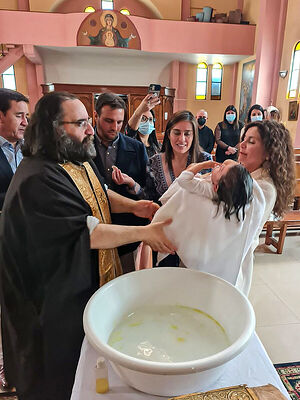 Priest Jorge Suez performs the sacrament of Baptism —The then priest in Vina del Mar, Fr. Stavros, was very ill, so the community was looking for an assistant priest for him. As a result, it was decided to send me here. I like it in Vina del Mar, especially since my close relatives live here.
Priest Jorge Suez performs the sacrament of Baptism —The then priest in Vina del Mar, Fr. Stavros, was very ill, so the community was looking for an assistant priest for him. As a result, it was decided to send me here. I like it in Vina del Mar, especially since my close relatives live here.
—And the church you came to serve in apparently had a well-established community?
—Fr. Stavros, who served in Vina, came to Chile in 1961. His father, also a priest, was a martyr—he was murdered by Turks who crucified him on the church door. Fearing Turkish persecution, the family moved from Smyrna to Jerusalem, where there was a large Greek diaspora. After the Second World War, Fr. Stavros was ordained a priest. He was invited to Chile from Baghdad, where he then served. The community needed a priest who could speak Greek and Arabic—these were the main languages of the local parishioners. But Fr. Stavros belonged to the so–called “old school”—in effect, his ministry was limited to celebrating the Liturgy on Sundays and performing services of need, such as baptisms, weddings and funerals. Unfortunately, pastoral work was overlooked. Over time, the emigrant generation died out, and as a result, the number of parishioners declined dramatically.
“Once I had a situation where I couldn’t start the Liturgy,” Fr. Jorge recounted. “No one came to the service—the church was empty. I understood that changes were needed. I began to serve in Spanish in order to make our church and services more open to people around us. For Chileans, including descendants of emigrants, church services have become clearer; in addition, we have begun pastoral work with people of all ages, holding meetings, reading the Bible, and answering questions. Thanks to this, the community has begun to grow. We have introduced the practice of celebrating services not only on Sundays, but also on weekdays, trying to attract parishioners to help during services (for example, reading and singing).”
—As I understand it, the translation of services into Spanish may have caused discontent among the older generation?
—By that time hardly any of them was alive. In addition, I have not given up Greek and Arabic completely—sometimes I use them in services. Unfortunately, I don’t know Russian, although we have some parishioners from Russia, Ukraine, Romania and Serbia. But they all listen to the Liturgy in Spanish quietly. On the major Greek holidays (for example, Greek Independence Day, or Ohi Day) a significant part of the Liturgy is celebrated in Greek. However, in any case, Spanish is the dominant liturgical language in our parish.
—Perhaps thanks to the Spanish language the Chileans have begun to show more interest in Orthodoxy?
—People do quit the Catholic Church, but chiefly because they are horrified by cases of pedophilia among Catholic clergy.
And one of the factors contributing to Chileans’ conversion to Orthodoxy is that they see a married priest who has children. They see me with my family at the market, in a supermarket and realize that this priest is a normal person like them, living a normal life. People can talk to me more freely about their daily problems, about what worries them.
—Fr. Jorge, as a father with many children (I am raising four children) I always wonder what should be done to ensure that children stay in the Church, especially in a situation where they are surrounded by the secular world, which is often hostile to Christianity?
—Yes, children usually attend church until they are twelve or thirteen, and after that they have other interests: parties on Saturdays, football, ballet, etc. They say that going to church is boring, they don’t like it. But we have a rule in our family: You can do whatever you want, but from eleven to twelve on Sunday you must be in church. Although, frankly speaking, I do not have ready-made solutions to this problem. Parishioners complain that their children don’t want to go to services. But there are often situations when, for example, the fathers themselves don’t attend services—they sleep late on Sundays and allow their children to oversleep and miss the Liturgy. Don’t forget that temptations in the West are very strong.
—In the West? You mean Chile?
—Yes, I consider Chile as part of the Western world compared to the Middle East or Russia. Here at the age of twelve children sometimes start drinking, smoking, and taking drugs. At the age of thirteen or fourteen they become “sexually active”. In general, we need personal motivation, an understanding that the Church is important for spiritual life. We often have a consumer attitude towards the church. If someone’s relative dies, we know that a funeral service must be performed over him; if someone was born, we know that he must be baptized, and so on. But people should strive to improve their spiritual state.
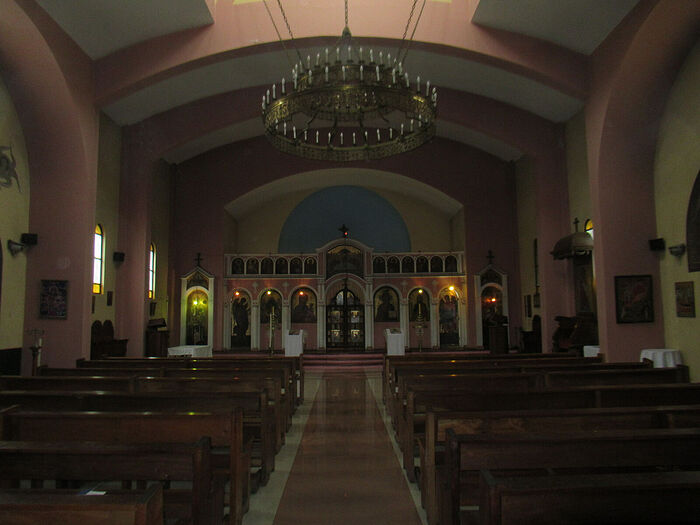 At the Church of the Dormition of the Mother of God
At the Church of the Dormition of the Mother of God
—In your view, is the educational system in Chile acceptable for Orthodox Christians?
—Many of our parishioners’ children go to Catholic schools—everything there is built around the liturgical cycle of the Catholic Church. Children receive their first Communion and get confirmed. It is difficult to refuse, otherwise you will be a black sheep.
Of course, secular schools don’t have all this—there are no religious lessons in them, only ethics. In such schools, children are instilled with a tolerant attitude, for example, towards same-sex marriage. And we see that at the age of fourteen children declare their homosexuality and enter into same-sex relationships.
—Are locals interested in the Orthodox Church on a street of their own town?
—Older people are interested in the Liturgy as such, as it resembles what was in the Catholic Church prior to Vatican II. Sometimes these people come to our services.... In general, we try to organize everything so that our parishioners would not feel abandoned. We have a playroom for children with drawing supplies and various toys. There is also a hall where people of different ages can chat over a cup of coffee after the Liturgy. Unfortunately, nowadays many people are busy with their cellphones and no longer have the time or desire for personal communication. We would like to change this trend a bit. And, of course, to enlighten people we need more accessible literature in Spanish, including proper translations of the Fathers of the Church.

